Excerpts from Jim Conrad's
Naturalist Newsletter
from the July 24, 2016 Newsletter issued from Hacienda Chichen Resort beside Chichén Itzá Ruins; limestone bedrock; elevation ~39m (~128ft), N20.675°, W88.569°; central Yucatán state, MÉXICO
AN HERBACEOUS BAMBOO
With the rainy season's arrival the forest is dark and shadowy, and when an understory plant happens to be enjoying its moment in a sunbeam, it shows up as if beneath a spotlight. Such was the case with the knee-high grass shown below:
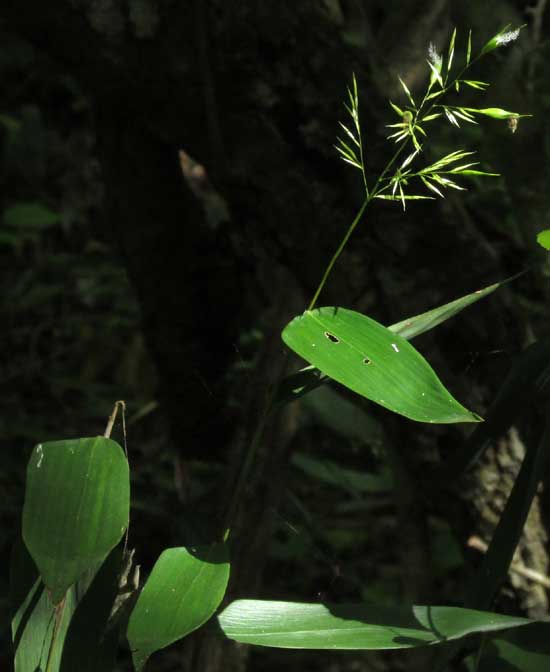
Anyone familiar with North American grasses might see a resemblance between this one's broad leaves and those of the big group known as the panic grasses. However, the flowering spikelets above the vegetative parts don't look like panic grass flowers, which are spherical to oblong. This is something new for us. A closer look at the leaves is shown below:
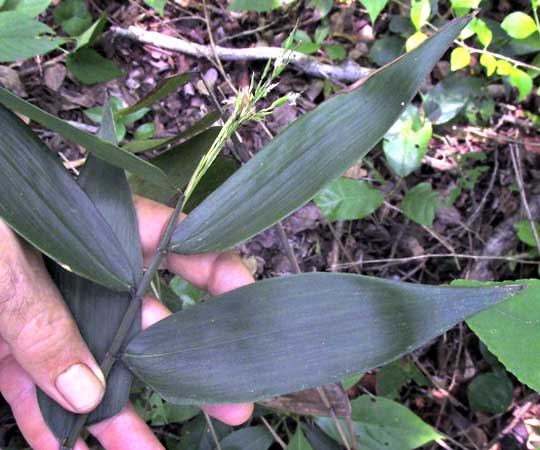
The bases of panic grass leaves tend to partly wrap around the stem, but here the blades' bases narrow as they approach the stem and don't embrace it at all. A closer look at a leaf base shows something remarkable, a field mark seldom seen among grasses, and that's a petiole-like structure, sometimes known as a pseudopetiole, shown below:
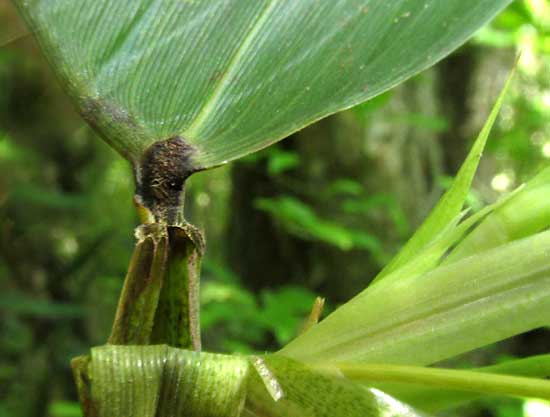
In that picture the blackish pseudopetiole at its bottom fuses with the top of the sheath that wraps around the stem below the point of blade attachment. Here we also see that the ligule at the top of the sheath consists of no more than a very low, thin membrane bearing a few extremely short and fine hairs, or cilia.
At the grass's base we find remains of stiff, somewhat woody stems from previous seasons, which brings to mind the bamboos, as you can see below:
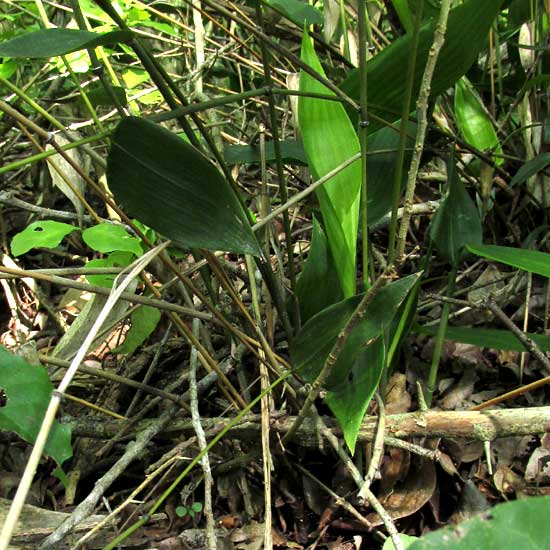
Along with its unusual vegetative features, this grass's flowers, or florets, also are a little unusual, in that they are unisexual. We've come onto the grass exactly when each of its few, large female florets bears two exceptionally conspicuous, feathery styles, as shown below:
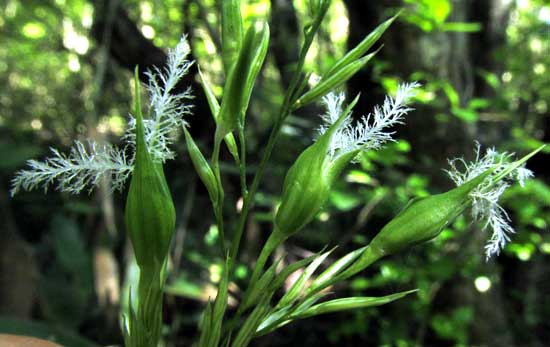
In that photo, the smaller florets above the large female ones are the unisexual male ones, at this moment not yet mature. Having its female flowers mature before its male ones assures that the grass's flowers don't self pollinate.
With such peculiar and easily seen field marks, this species was easy to identify as OLYRA LATIFOLIA, found in Mexico and the Caribbean south through Central America to northern Argentina in South America, plus it's become naturalized in Africa. Within the Grass Family, the Poaceae, the genus Olyra falls into the Bamboo Subfamily, the Bambusoideae, and tribe Olyreae, so we can think about it as a kind of bamboo.
A 2013 paper by Scot Kelchner and others in Molecular Phylogenetics and Evolution, reporting on gene analysis of numerous members of the Bamboo Subfamily, the Bambusoideae, found that species within the subfamily tend to fall into four major groupings: temperate woody, Old World tropical (paleotropical) woody , New World Tropical (neotropical) woody, and herbaceous bamboos. Our grass in the genus Olyra is considered as a member of the herbaceous bamboo group -- despite the fact that some technical descriptions describe the species as producing woody stems.
It's hard to say where herbaceousness ends and woodiness begins, but it's clear that our Olyra latifolia is much more herbaceous than most other bamboos.
So, who would have thought it? An herbaceous bamboo...
from the February 25, 2018 Newsletter issued from Rancho Regenesis in the woods ±4kms west of Ek Balam Ruins; elevation ~40m (~130 ft), N20.876°, W88.170°; north-central Yucatán, MÉXICO
AN HERBACEOUS BAMBOO'S HANDSOME SEEDS
On the Internet I find no good close-ups of the caryopsis-type fruit of Olyra latifolia . Therefore, when I stumbled upon a good fruiting plant this week I was tickled. Below, you can see the fruiting head
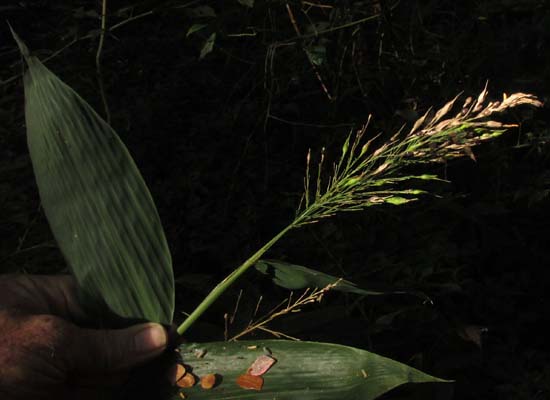
One of the main field marks of Olyra latifolia is the petiole-like "pseudopetiole" with which the blade attaches to the sheath around the stem, so I photographed it, too, seen below:
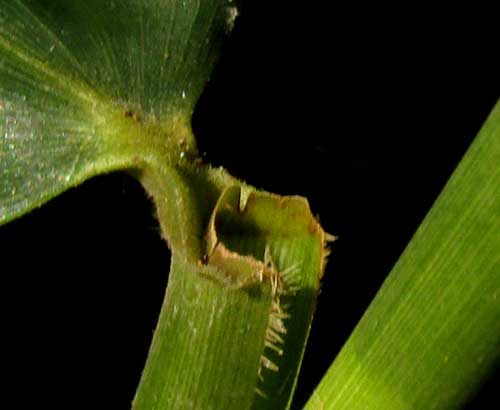
And the remarkably large, handsome caryopsis-type fruits are shown below:
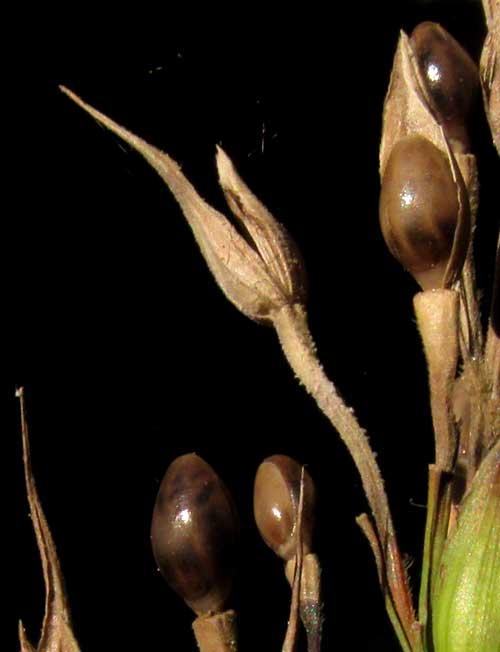
Olyra latifolia is monoecious, meaning that each plant bears both male and female unisexual flowers. In this species the unisexual flowers are segregated on inflorescence branches that may bear only flowers of one sex, or have them mixed together.